Qu Yang
Doc-Researcher: A Unified System for Multimodal Document Parsing and Deep Research
Oct 24, 2025Abstract:Deep Research systems have revolutionized how LLMs solve complex questions through iterative reasoning and evidence gathering. However, current systems remain fundamentally constrained to textual web data, overlooking the vast knowledge embedded in multimodal documents Processing such documents demands sophisticated parsing to preserve visual semantics (figures, tables, charts, and equations), intelligent chunking to maintain structural coherence, and adaptive retrieval across modalities, which are capabilities absent in existing systems. In response, we present Doc-Researcher, a unified system that bridges this gap through three integrated components: (i) deep multimodal parsing that preserves layout structure and visual semantics while creating multi-granular representations from chunk to document level, (ii) systematic retrieval architecture supporting text-only, vision-only, and hybrid paradigms with dynamic granularity selection, and (iii) iterative multi-agent workflows that decompose complex queries, progressively accumulate evidence, and synthesize comprehensive answers across documents and modalities. To enable rigorous evaluation, we introduce M4DocBench, the first benchmark for Multi-modal, Multi-hop, Multi-document, and Multi-turn deep research. Featuring 158 expert-annotated questions with complete evidence chains across 304 documents, M4DocBench tests capabilities that existing benchmarks cannot assess. Experiments demonstrate that Doc-Researcher achieves 50.6% accuracy, 3.4xbetter than state-of-the-art baselines, validating that effective document research requires not just better retrieval, but fundamentally deep parsing that preserve multimodal integrity and support iterative research. Our work establishes a new paradigm for conducting deep research on multimodal document collections.
BatonVoice: An Operationalist Framework for Enhancing Controllable Speech Synthesis with Linguistic Intelligence from LLMs
Sep 30, 2025Abstract:The rise of Large Language Models (LLMs) is reshaping multimodel models, with speech synthesis being a prominent application. However, existing approaches often underutilize the linguistic intelligence of these models, typically failing to leverage their powerful instruction-following capabilities. This limitation hinders the model's ability to follow text instructions for controllable Text-to-Speech~(TTS). To address this, we propose a new paradigm inspired by ``operationalism'' that decouples instruction understanding from speech generation. We introduce BatonVoice, a framework where an LLM acts as a ``conductor'', understanding user instructions and generating a textual ``plan'' -- explicit vocal features (e.g., pitch, energy). A separate TTS model, the ``orchestra'', then generates the speech from these features. To realize this component, we develop BatonTTS, a TTS model trained specifically for this task. Our experiments demonstrate that BatonVoice achieves strong performance in controllable and emotional speech synthesis, outperforming strong open- and closed-source baselines. Notably, our approach enables remarkable zero-shot cross-lingual generalization, accurately applying feature control abilities to languages unseen during post-training. This demonstrates that objectifying speech into textual vocal features can more effectively unlock the linguistic intelligence of LLMs.
LoRASculpt: Sculpting LoRA for Harmonizing General and Specialized Knowledge in Multimodal Large Language Models
Mar 21, 2025Abstract:While Multimodal Large Language Models (MLLMs) excel at generalizing across modalities and tasks, effectively adapting them to specific downstream tasks while simultaneously retaining both general and specialized knowledge remains challenging. Although Low-Rank Adaptation (LoRA) is widely used to efficiently acquire specialized knowledge in MLLMs, it introduces substantial harmful redundancy during visual instruction tuning, which exacerbates the forgetting of general knowledge and degrades downstream task performance. To address this issue, we propose LoRASculpt to eliminate harmful redundant parameters, thereby harmonizing general and specialized knowledge. Specifically, under theoretical guarantees, we introduce sparse updates into LoRA to discard redundant parameters effectively. Furthermore, we propose a Conflict Mitigation Regularizer to refine the update trajectory of LoRA, mitigating knowledge conflicts with the pretrained weights. Extensive experimental results demonstrate that even at very high degree of sparsity ($\le$ 5%), our method simultaneously enhances generalization and downstream task performance. This confirms that our approach effectively mitigates the catastrophic forgetting issue and further promotes knowledge harmonization in MLLMs.
Spiking Neural Networks for Temporal Processing: Status Quo and Future Prospects
Feb 13, 2025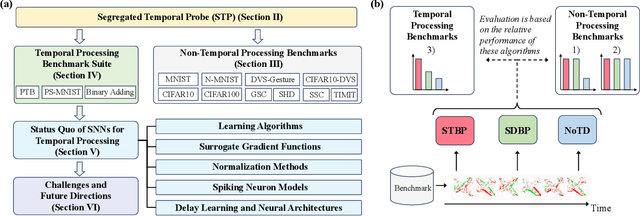

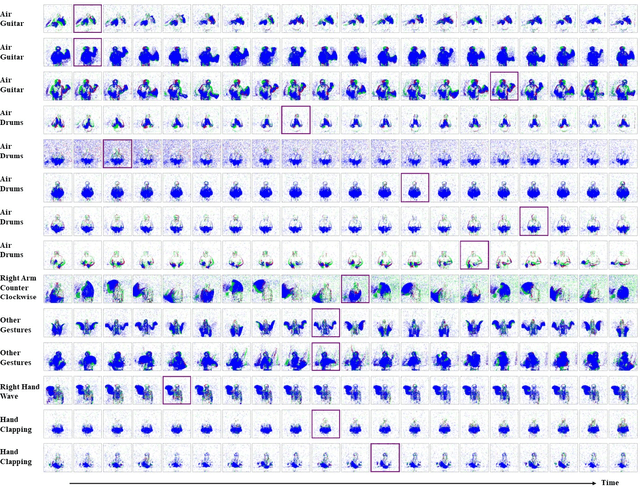
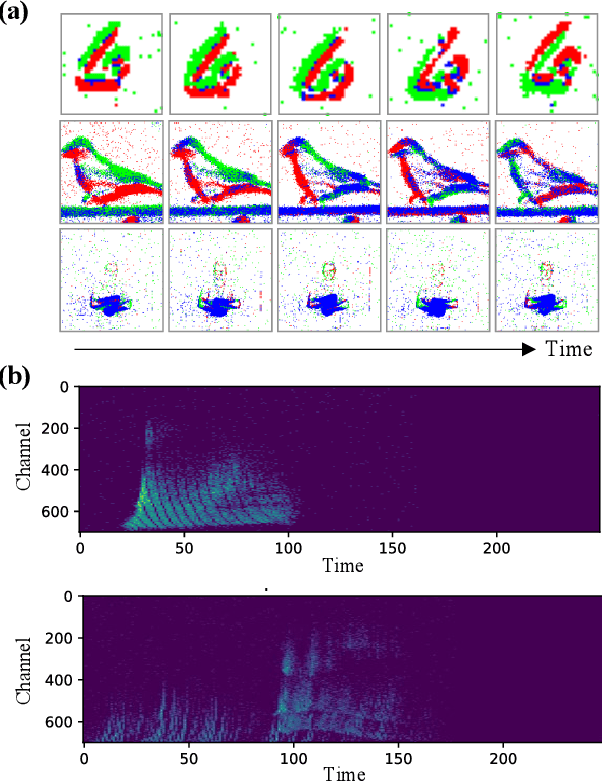
Abstract:Temporal processing is fundamental for both biological and artificial intelligence systems, as it enables the comprehension of dynamic environments and facilitates timely responses. Spiking Neural Networks (SNNs) excel in handling such data with high efficiency, owing to their rich neuronal dynamics and sparse activity patterns. Given the recent surge in the development of SNNs, there is an urgent need for a comprehensive evaluation of their temporal processing capabilities. In this paper, we first conduct an in-depth assessment of commonly used neuromorphic benchmarks, revealing critical limitations in their ability to evaluate the temporal processing capabilities of SNNs. To bridge this gap, we further introduce a benchmark suite consisting of three temporal processing tasks characterized by rich temporal dynamics across multiple timescales. Utilizing this benchmark suite, we perform a thorough evaluation of recently introduced SNN approaches to elucidate the current status of SNNs in temporal processing. Our findings indicate significant advancements in recently developed spiking neuron models and neural architectures regarding their temporal processing capabilities, while also highlighting a performance gap in handling long-range dependencies when compared to state-of-the-art non-spiking models. Finally, we discuss the key challenges and outline potential avenues for future research.
A Survey on Multi-Turn Interaction Capabilities of Large Language Models
Jan 17, 2025Abstract:Multi-turn interaction in the dialogue system research refers to a system's ability to maintain context across multiple dialogue turns, enabling it to generate coherent and contextually relevant responses. Recent advancements in large language models (LLMs) have significantly expanded the scope of multi-turn interaction, moving beyond chatbots to enable more dynamic agentic interactions with users or environments. In this paper, we provide a focused review of the multi-turn capabilities of LLMs, which are critical for a wide range of downstream applications, including conversational search and recommendation, consultation services, and interactive tutoring. This survey explores four key aspects: (1) the core model capabilities that contribute to effective multi-turn interaction, (2) how multi-turn interaction is evaluated in current practice, (3) the general algorithms used to enhance multi-turn interaction, and (4) potential future directions for research in this field.
Towards Ultra-Low-Power Neuromorphic Speech Enhancement with Spiking-FullSubNet
Oct 07, 2024



Abstract:Speech enhancement is critical for improving speech intelligibility and quality in various audio devices. In recent years, deep learning-based methods have significantly improved speech enhancement performance, but they often come with a high computational cost, which is prohibitive for a large number of edge devices, such as headsets and hearing aids. This work proposes an ultra-low-power speech enhancement system based on the brain-inspired spiking neural network (SNN) called Spiking-FullSubNet. Spiking-FullSubNet follows a full-band and sub-band fusioned approach to effectively capture both global and local spectral information. To enhance the efficiency of computationally expensive sub-band modeling, we introduce a frequency partitioning method inspired by the sensitivity profile of the human peripheral auditory system. Furthermore, we introduce a novel spiking neuron model that can dynamically control the input information integration and forgetting, enhancing the multi-scale temporal processing capability of SNN, which is critical for speech denoising. Experiments conducted on the recent Intel Neuromorphic Deep Noise Suppression (N-DNS) Challenge dataset show that the Spiking-FullSubNet surpasses state-of-the-art methods by large margins in terms of both speech quality and energy efficiency metrics. Notably, our system won the championship of the Intel N-DNS Challenge (Algorithmic Track), opening up a myriad of opportunities for ultra-low-power speech enhancement at the edge. Our source code and model checkpoints are publicly available at https://github.com/haoxiangsnr/spiking-fullsubnet.
EmoLLM: Multimodal Emotional Understanding Meets Large Language Models
Jun 24, 2024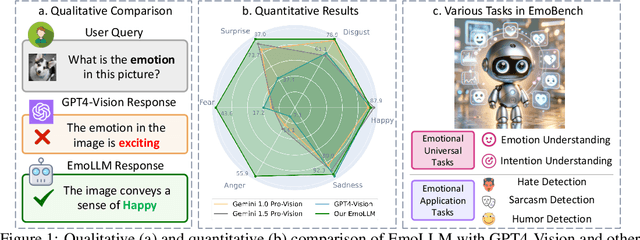
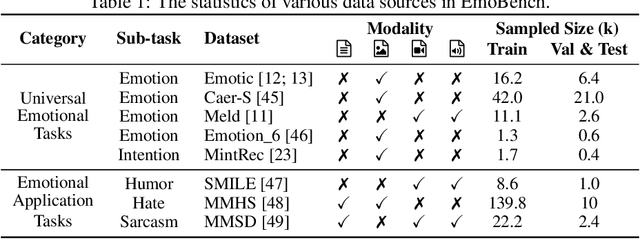
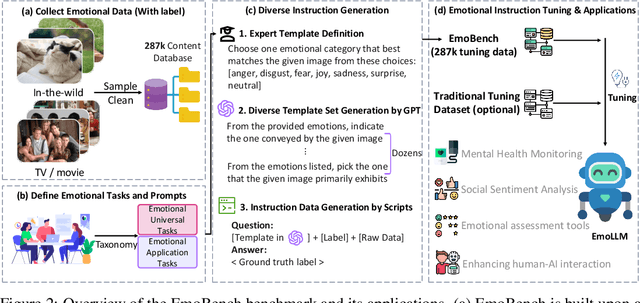

Abstract:Multi-modal large language models (MLLMs) have achieved remarkable performance on objective multimodal perception tasks, but their ability to interpret subjective, emotionally nuanced multimodal content remains largely unexplored. Thus, it impedes their ability to effectively understand and react to the intricate emotions expressed by humans through multimodal media. To bridge this gap, we introduce EmoBench, the first comprehensive benchmark designed specifically to evaluate the emotional capabilities of MLLMs across five popular emotional tasks, using a diverse dataset of 287k images and videos paired with corresponding textual instructions. Meanwhile, we propose EmoLLM, a novel model for multimodal emotional understanding, incorporating with two core techniques. 1) Multi-perspective Visual Projection, it captures diverse emotional cues from visual data from multiple perspectives. 2) EmoPrompt, it guides MLLMs to reason about emotions in the correct direction. Experimental results demonstrate that EmoLLM significantly elevates multimodal emotional understanding performance, with an average improvement of 12.1% across multiple foundation models on EmoBench. Our work contributes to the advancement of MLLMs by facilitating a deeper and more nuanced comprehension of intricate human emotions, paving the way for the development of artificial emotional intelligence capabilities with wide-ranging applications in areas such as human-computer interaction, mental health support, and empathetic AI systems. Code, data, and model will be released.
ED-sKWS: Early-Decision Spiking Neural Networks for Rapid,and Energy-Efficient Keyword Spotting
Jun 14, 2024Abstract:Keyword Spotting (KWS) is essential in edge computing requiring rapid and energy-efficient responses. Spiking Neural Networks (SNNs) are well-suited for KWS for their efficiency and temporal capacity for speech. To further reduce the latency and energy consumption, this study introduces ED-sKWS, an SNN-based KWS model with an early-decision mechanism that can stop speech processing and output the result before the end of speech utterance. Furthermore, we introduce a Cumulative Temporal (CT) loss that can enhance prediction accuracy at both the intermediate and final timesteps. To evaluate early-decision performance, we present the SC-100 dataset including 100 speech commands with beginning and end timestamp annotation. Experiments on the Google Speech Commands v2 and our SC-100 datasets show that ED-sKWS maintains competitive accuracy with 61% timesteps and 52% energy consumption compared to SNN models without early-decision mechanism, ensuring rapid response and energy efficiency.
sVAD: A Robust, Low-Power, and Light-Weight Voice Activity Detection with Spiking Neural Networks
Mar 09, 2024Abstract:Speech applications are expected to be low-power and robust under noisy conditions. An effective Voice Activity Detection (VAD) front-end lowers the computational need. Spiking Neural Networks (SNNs) are known to be biologically plausible and power-efficient. However, SNN-based VADs have yet to achieve noise robustness and often require large models for high performance. This paper introduces a novel SNN-based VAD model, referred to as sVAD, which features an auditory encoder with an SNN-based attention mechanism. Particularly, it provides effective auditory feature representation through SincNet and 1D convolution, and improves noise robustness with attention mechanisms. The classifier utilizes Spiking Recurrent Neural Networks (sRNN) to exploit temporal speech information. Experimental results demonstrate that our sVAD achieves remarkable noise robustness and meanwhile maintains low power consumption and a small footprint, making it a promising solution for real-world VAD applications.
LC-TTFS: Towards Lossless Network Conversion for Spiking Neural Networks with TTFS Coding
Oct 23, 2023
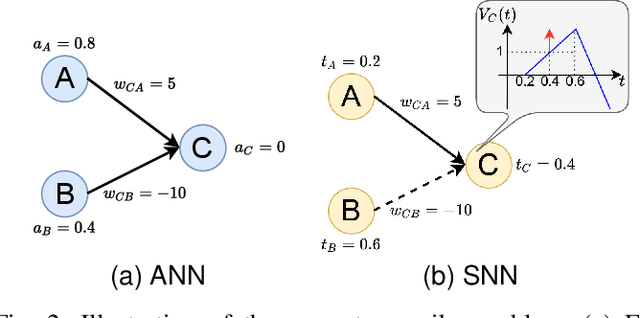
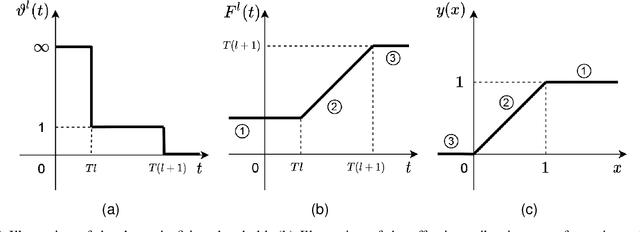
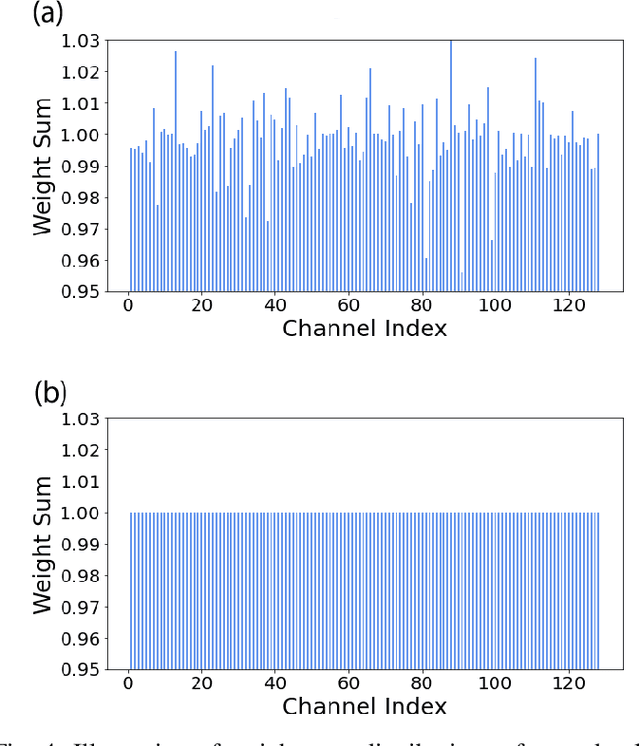
Abstract:The biological neurons use precise spike times, in addition to the spike firing rate, to communicate with each other. The time-to-first-spike (TTFS) coding is inspired by such biological observation. However, there is a lack of effective solutions for training TTFS-based spiking neural network (SNN). In this paper, we put forward a simple yet effective network conversion algorithm, which is referred to as LC-TTFS, by addressing two main problems that hinder an effective conversion from a high-performance artificial neural network (ANN) to a TTFS-based SNN. We show that our algorithm can achieve a near-perfect mapping between the activation values of an ANN and the spike times of an SNN on a number of challenging AI tasks, including image classification, image reconstruction, and speech enhancement. With TTFS coding, we can achieve up to orders of magnitude saving in computation over ANN and other rate-based SNNs. The study, therefore, paves the way for deploying ultra-low-power TTFS-based SNNs on power-constrained edge computing platforms.
 Add to Chrome
Add to Chrome Add to Firefox
Add to Firefox Add to Edge
Add to Edge